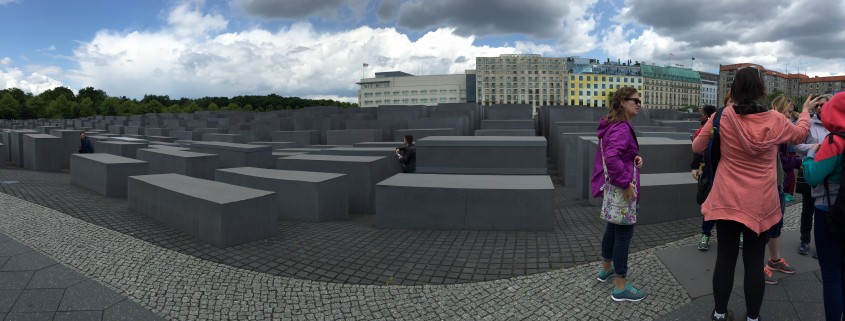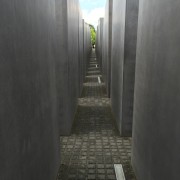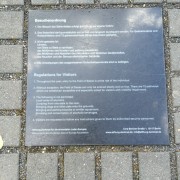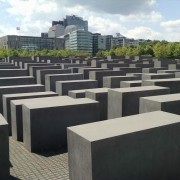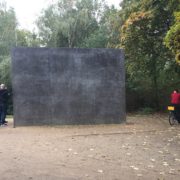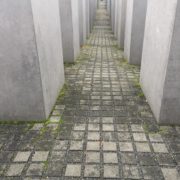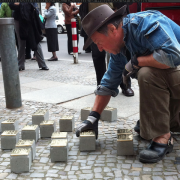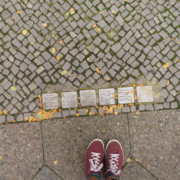The Memorial to the Murdered Jews of Europe: Adequate Enough?
By Meagan Edwards
In the heart of Berlin there lies a monument. The enormity of this monument catches the eye of whoever walks or drives by regardless if they are in Berlin to see it or not. Approaching the monument one will enter a maze of rectangle-shaped stone structures (or steleae). Seemingly identical to one another, not two stones are alike varying in height and width, nor are any of the stones standing at the same angle. The spaces between the stones, however, create perfectly perpendicular alley ways. When reaching the middle of the maze, one can look above into the sky and the stones will almost double their height (especially if the visitor is, like me, only five feet tall). They will also notice that the ground shifts in height and angles as well. Upon exiting you will experience the same atmosphere as you did when entering. Hundreds are gathered at this monument. People are casually relaxing as they sit upon each stone and mingling with their peers. It is a playground for children (and adults) who choose to chase one another around hiding and seeking. People are yelling through the maze, as well as trying to hoist one another up to reach the top of the tallest steleae. Everyone here is enjoying themselves. Everyone except those who know what the monument is memorializing.
This memorial is dedicated to the murdered Jews of Europe, the millions who lost their lives during the Holocaust under the order of the Third Reich. This monument, like the Holocaust, because of its enormity, is a wound in German history that cannot be bandaged and covered. It is extremely visible and will remain that way because Germany, like everyone who passes by the monument, is forced to acknowledge it. While on a visit to Berlin, my study group was brought to this particular site. For me, the experience was different from that of the visitors I saw at the memorial and described. I cannot blame those people for acting the way they had, for there is no mention anywhere on the site that would explicitly state that this is a monument dedicated to the six million innocent Jews whose lives were taken from them. If I had not known, I, like the others, may have thought this place to be a park for the entertainment of the inhabitants of Berlin. There are inscriptions on the ground upon entering the monument that lists a number of rules such as “no loud noise of any kind” or “no jumping from one steleae to another.” These inscriptions are easily overlooked and walked over. I, myself, did not notice them until I purposely looked for some sign that this place is a monument at all.
My initial reactions to this “site of memory” included a great deal of disappointment. I was uneasy walking through the steleae. I gradually became smaller, running into children who took turns too quickly. I was entirely uncomfortable. Trying to remember and memorialize the victims became nearly impossible over the sounds of screaming children and drunken adults. Walking out of the site, I was disgusted that there were people using this site as a backdrop for pictures of smiling people, happy as can be. Honestly, I was disgusted by all of the people using this place for anything other than a place of memorializing. Nobody would dare act this way at the Arlington National Cemetery in Washington D.C, a national cemetery run by the United States Army for those who died serving and protecting their country. But like I said before, that is because those who visit the Arlington National Cemetary know what they are seeing. Each headstone represents a soldier who believed in his country until their very end. At the Monument for the Murdered Jews of Europe, the stones resemble coffins, but there are no names of the people who believed themselves to be of German or Polish heritage first, and of Jewish faith second. There is no silence, no ceremonies, no mention or recognition at all. There is nothing but a maze of uneven stones.
As I sat down and started to reflect on this place I forced myself to push my anger and disgust aside. I tried to develop an understanding. I tried to put myself in the architect’s shoes, an American named Peter Eisenman. What I did understand from the beginning, was the placement of the memorial. The center of the capitol of Germany seems perfectly suitable, considering it was German orders and German commands that carried out the systematic murder. I understood then that the perfectly perpendicular paths with shifting grounds made of even stones placed at different angles possibly represented German order, which itself was very organized, but as the Jewish question proceeded and the war not going as planned, faced obstacles and was rushed. The Jews of Europe were forced to travel these paths, running into one another around sharp turns, just as I had, being swallowed by the enormity, confusion, and quickness of what was happening to them. The Jews were experiencing the cruelty of the Third Reich, while outsiders, those who may not understand what is really going on, carried on with their lives, just as the people enjoying themselves at the monument had done. Ultimately, what I decided was that this was my interpretation and that anyone else looking at this monument had their own interpretation. I believe that this is what the architect wanted.
Although I still believe that it should be made visible that the Memorial for the Murdered Jews of Europe is in fact, a memorial dedicated to the murdered Jews of Europe, I understand the monument. It is a heartache and an uncomfortable experience for anyone who knows what it is, but nothing out of the ordinary for those who do not understand. The monument raises questions and is open to different interpretations. There is a heated debate about the adequacy of the monument, but I believe it somehow makes sense. Can a monument memorializing the murder of six million Jews ever be truly representative if the murder itself cannot ever be truly understood?
All photos attached were taken by Meagan Edwards

